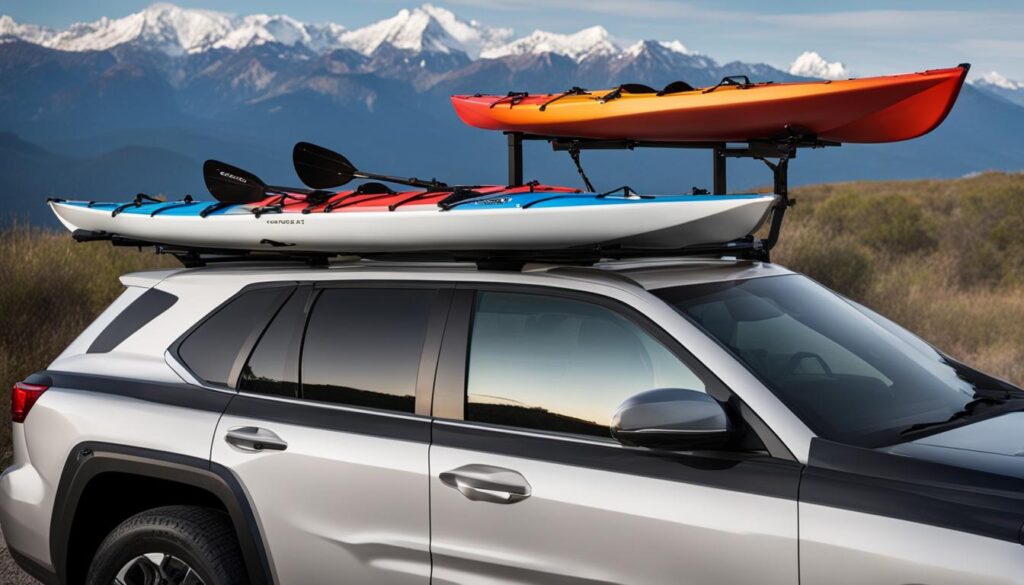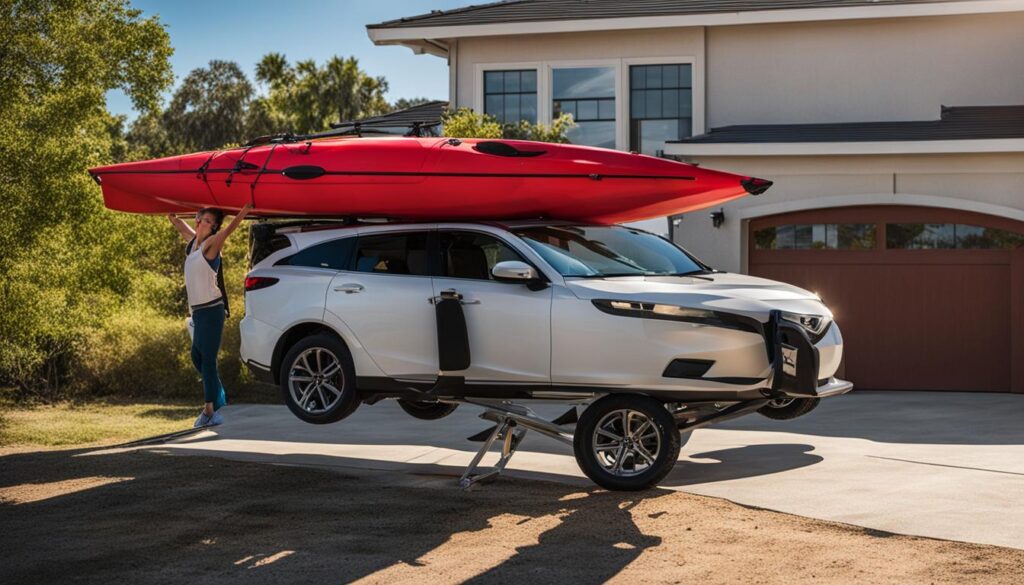When it comes to transporting your kayak, having a reliable roof rack is essential. There are four main types of kayak racks to choose from: J-Cradles, Saddles, Stackers, and Temporary Pads. J-Cradles are versatile and side-loading, making them popular among kayakers. Saddles are a great choice for transporting one kayak at a time, offering a large surface area for stability. Stackers are ideal for transporting multiple kayaks vertically and on their sides, maximizing space. Temporary pads are easy to install and remove, making them perfect for short trips. Consider the type of kayak you have and your vehicle’s roof size when choosing a roof rack.
Key Takeaways:
- Choosing a reliable roof rack is essential for safe and secure kayak transportation.
- J-Cradles, Saddles, Stackers, and Temporary Pads are the four main types of kayak racks.
- J-Cradles are versatile, Saddles provide stability, Stackers maximize space, and Temporary Pads are convenient for short trips.
- Consider the type of kayak you have and your vehicle’s roof size when selecting a roof rack.
- Follow manufacturer’s instructions for installation, tie-down, and loading to ensure proper usage of the roof rack.
Types of Kayak Racks
When it comes to transporting your kayak, having the right roof rack is crucial. There are four main types of kayak racks to choose from, each with its own unique features and benefits. Understanding these options will help you make an informed decision based on your specific needs and preferences.
J-Cradles
J-Cradles are a popular choice among kayakers due to their versatility and side-loading design. These racks hold the kayak in a J-shaped cradle, providing secure support and preventing the kayak from shifting during transportation. With J-Cradles, you can easily load and unload your kayak from the side, making them an ideal option for kayaks with a larger width or when you have limited overhead clearance.
Saddles
Saddles, also known as kayak rollers or kayak carriers, offer a large surface area and provide excellent stability for transporting one kayak at a time. They feature a padded surface that cradles the kayak, reducing the risk of damage and scratches. Saddles are best suited for kayaks with a narrower width and can be easily adjusted to fit different sizes. They are a great choice for those who frequently transport a single kayak and prioritize stability during transport.
Stackers
If you need to transport multiple kayaks, stackers are a practical solution. These racks allow you to transport kayaks in a vertical position, stacking them on top of each other. Stackers make efficient use of space and are ideal for those who need to transport two or more kayaks. By storing the kayaks on their sides, you can maximize roof space and carry multiple kayaks without sacrificing stability.
Temporary Pads
Temporary pads, also known as foam blocks or kayak foam pads, offer a simple and affordable option for short trips or occasional kayak transportation. These pads can be easily installed and removed, providing a cushioned surface for your kayak. Temporary pads are a versatile option that can be used on vehicles without a roof rack or when you need a temporary solution. However, they may not offer the same level of stability and security as other rack types.
When choosing a kayak rack, consider the type of kayak you have, the number of kayaks you plan to transport, and your specific transportation needs. Each type of rack offers unique advantages, so it’s important to evaluate your requirements and select the right option for a safe and hassle-free kayak transportation experience.
Factors to Consider Before Purchasing a Kayak Rack
Before purchasing a kayak rack, there are several factors you should take into account to ensure the best fit for your needs. Here are some key considerations:
- Number of transportable kayaks: Determine how many kayaks you plan to transport regularly. This will help you choose a rack that can accommodate the desired capacity. Some racks are designed to hold multiple kayaks, while others are better suited for single kayak transportation.
- Type of vehicle: Take into consideration the type of vehicle you have. Not all racks are compatible with every vehicle, so it’s important to choose one that fits securely and safely. Consider your vehicle’s roof size and shape, as well as any specific requirements or limitations it may have.
- Rack’s material: The material of the kayak rack is crucial for its durability and longevity. Look for racks made from high-quality materials, such as steel with a rust-free coating, to ensure they can withstand the elements and provide reliable support for your kayaks.
- Cross bar system: Check whether your vehicle already has a cross bar system installed. If not, you may need to purchase a compatible cross bar system along with your kayak rack. The cross bars provide the foundation for the rack and play a vital role in securing your kayaks during transportation.
By considering these factors, you can make an informed decision when purchasing a kayak rack that meets your specific needs and ensures the safe and secure transportation of your kayaks.
Table: Comparison of Key Factors Before Purchasing a Kayak Rack
| Factors | Considerations |
|---|---|
| Number of transportable kayaks | Choose a rack that can accommodate the desired capacity |
| Type of vehicle | Ensure compatibility with your vehicle’s roof size, shape, and requirements |
| Rack’s material | Look for high-quality materials that are durable and rust-free |
| Cross bar system | Check if your vehicle already has a compatible cross bar system or if you need to purchase one |
Remember, choosing the right kayak rack is crucial for the safe and secure transportation of your kayaks. Take the time to assess your needs, consider these factors, and make an informed decision to ensure a hassle-free kayaking experience.

How Many Kayaks Can a Roof Rack Hold?
When considering kayak transportation, one important question that often arises is how many kayaks a roof rack can hold. While the answer may vary depending on the specific roof rack model and design, most standard roof racks can securely hold two kayaks. However, it’s crucial to adhere to the recommended capacity to avoid any potential damage to the kayaks or the rack itself.
If you need to transport more than two kayaks, some roof racks are designed to accommodate up to four kayaks. These racks often allow for storage in a vertical position or sideways, maximizing space. It’s essential to refer to the manufacturer’s guidelines and specifications to ensure you do not exceed the recommended capacity for your specific roof rack.
Here is a table summarizing the capacity of different roof rack models:
| Rack Model | Capacity |
|---|---|
| J-Cradles | 2 kayaks |
| Saddles | 2 kayaks |
| Stackers | 4 kayaks |
| Temporary Pads | 2 kayaks |
Remember, it’s always crucial to follow the manufacturer’s guidelines and recommendations to ensure the safe and secure transportation of your kayaks. By selecting the appropriate roof rack and adhering to the specified capacity, you can confidently transport your kayaks to your next adventure.
How to Securely Tie Down a Kayak to a Roof Rack
Securing your kayak to the roof rack is crucial for safe transportation. Most manufacturers provide tie-down instructions with their racks, specifying anchor points and the proper way to secure the kayak. Typically, straps are used to create loops around the kayak’s body, ensuring it is tight enough to not slip off during transportation but not so tight that it damages the boat. Bow and stern lines are also important for additional stability, preventing the kayak from shifting forward or backward in case of sudden stops or accidents. Follow the manufacturer’s instructions and use proper knots to secure the straps and ropes.
When tying down your kayak, make sure to:
- Place the kayak on the roof rack and position it in the center.
- Pass the straps underneath the roof rack bars, making sure they are securely fastened.
- Create loops around the kayak’s body using the straps, ensuring they are tight enough to prevent movement but not too tight to cause damage.
- Attach bow and stern lines to the front and back of the kayak, securing them to proper anchor points on your vehicle.
Remember, the key is to secure the kayak tightly enough to prevent it from shifting or coming loose during transportation, while still ensuring the straps and ropes do not damage the kayak’s hull. Taking the time to properly tie down your kayak will give you peace of mind knowing it is secure and ready for the journey ahead.
| Advantages | Disadvantages | |
|---|---|---|
| J-Cradles | Provides excellent stability Side-loading design Versatile for different kayak shapes and sizes |
Requires lifting kayak higher for loading May limit roof space for other equipment |
| Saddles | Large surface area for stability Easy loading and unloading for one kayak |
May require additional racks for multiple kayaks Limited roof space for other gear |
| Stackers | Maximizes roof space by stacking kayaks vertically Easy to load and unload multiple kayaks |
Requires lifting kayaks higher May be less stable than other options |
| Temporary Pads | Easy and quick installation Can be used on various vehicle roofs Affordable option |
May not provide the same level of stability May not be suitable for long-distance travel |
How to Load a Kayak onto a Roof Rack
Once you have chosen the right roof rack for your kayak transportation needs, it’s time to learn how to load your kayak onto the rack securely. Follow these step-by-step instructions to ensure a safe and efficient loading process.
1. Prepare your kayak: Before loading your kayak, make sure it is free from water and any other gear. This will help prevent any damage to your car’s roof. You can also use a protective cover or a sheet to avoid scratches.
2. Position your vehicle: Park your vehicle on a flat surface and ensure it is stable. If needed, use wheel chocks to prevent any movement.
3. Position the roof rack: Ensure that your roof rack is properly installed and adjusted according to the manufacturer’s instructions.
4. Lift the kayak onto the roof rack: Depending on the weight and size of your kayak, you may need assistance with this step. If your roof rack has sliding bars, position them to support the weight of the kayak during the loading process. Lift the kayak onto the rack, positioning it parallel to the vehicle.
5. Secure the kayak: Once the kayak is on the roof rack, follow the tie-down instructions provided by the manufacturer. Use straps to create loops around the kayak’s body, ensuring it is tight enough to prevent any slipping, but not too tight to damage the boat. Don’t forget to use bow and stern lines for additional stability.
By following these guidelines, you can load your kayak onto a roof rack safely and efficiently, ensuring a smooth and enjoyable journey to your paddling destination.

Table: Comparison of Different Roof Rack Types
| Rack Type | Pros | Cons |
|---|---|---|
| J-Cradles | Side-loading, versatile | May require lifting kayak higher |
| Saddles | Stable, ideal for one kayak | Occupies more space |
| Stackers | Vertical storage, space-saving | May be more challenging to load multiple kayaks |
| Temporary Pads | Easy to install and remove | Not suitable for long trips |
Conclusion
Choosing the right roof rack for your kayak transportation needs is crucial to ensure the safety and security of your equipment. Whether you prefer J-Cradles, Saddles, Stackers, or Temporary Pads, there is a roof rack out there that will meet your unique requirements.
When making your decision, consider the type of kayak you own and the number of kayaks you plan to transport. Additionally, take into account the specific features of your vehicle’s roof, as different roof racks may be more compatible with certain vehicles.
Remember to carefully follow the manufacturer’s instructions for installation, tie-down, and loading. This will help ensure that your kayak is securely fastened to the roof rack during transportation.
With the right roof rack, you can enjoy peace of mind and convenience as you embark on your kayaking adventures. So, take the time to choose the perfect roof rack for your kayaks, and get ready to hit the water with confidence!
FAQ
What are the main types of kayak racks?
The main types of kayak racks are J-Cradles, Saddles, Stackers, and Temporary Pads.
How do J-Cradles work?
J-Cradles are versatile and allow for side-loading of kayaks.
What are Saddles used for?
Saddles provide a large surface area for stability and are ideal for transporting one kayak at a time.
What is the benefit of using Stackers?
Stackers allow for vertical transportation of multiple kayaks, maximizing space.
Are Temporary Pads easy to install?
Yes, Temporary Pads are easy to install and remove, making them perfect for short trips.
What factors should I consider before purchasing a kayak rack?
You should consider the number of kayaks you plan to transport, the type of vehicle you have, the rack’s material, and whether your vehicle has a compatible cross bar system installed.
How many kayaks can a standard roof rack hold?
A standard roof rack can typically hold two kayaks securely, with additional fasteners available for tying down more kayaks.
How do I secure a kayak to a roof rack?
Follow the manufacturer’s tie-down instructions, which usually involve creating loops around the kayak’s body using straps. Bow and stern lines are also important for additional stability.
How do I load a kayak onto a roof rack?
Many roof racks come with sliding bars to support the weight of the kayak during loading. Ensure the kayak is free from water and other gear before lifting it onto the rack. Follow the manufacturer’s instructions for proper tie-down.





